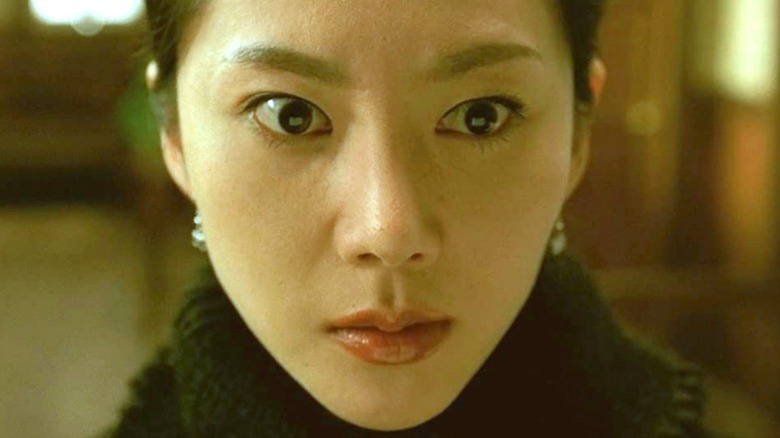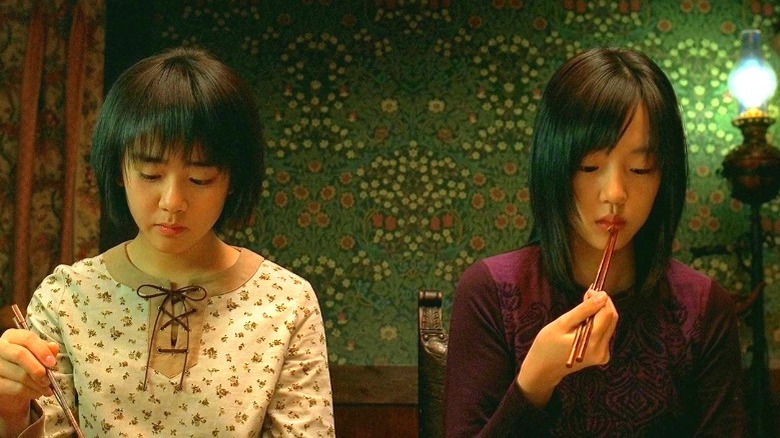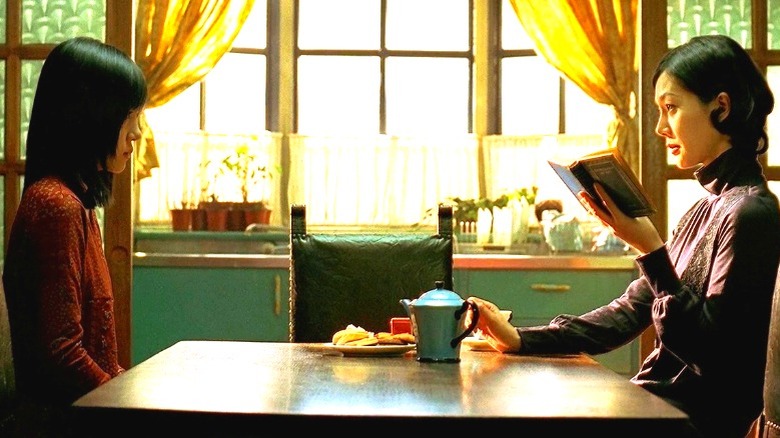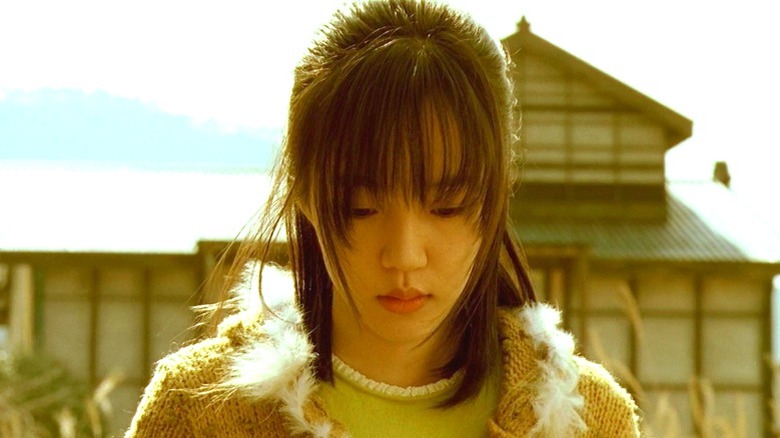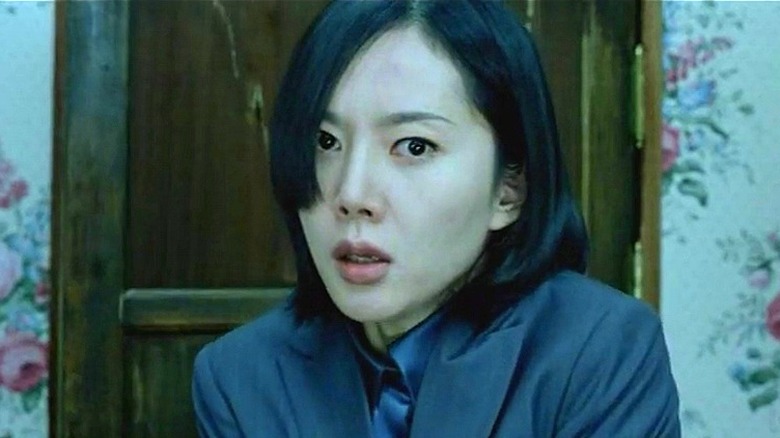The Ending Of A Tale Of Two Sisters Explained
Evil stepmothers are a common trope in many haunting tales, but in "A Tale of Two Sisters," Eun-joo (Jung-ah Yum) takes it to the next level. Decidedly deserving of its placement in the zeitgeist of underrated Korean horror movies, Jee-woon Kim's classic film is inspired by the mythic tale about a stepmother out to get her stepdaughters (via Variety).
When two sisters Su-mi (Soo-jung Lim) and Su-yeon (Geun-young Moon) return home after a stay in a mental health facility, Eun-joo is none too happy to receive them. She may seem at first like a caring homemaker, but this front collapses almost immediately. Instead, the girls are subjected to furious outbursts while their father Moo-hyeon (Kap-su Kim) looks on with vacant neglect. Worst father of the year? Probably. But that is nothing compared to the additional nightmare of ghosts haunting every corner. The audience becomes just as disoriented as the characters, unsure of what the underlying connection tying the spooks to the family trauma together is.
If you can get to watch "A Tale of Two Sisters," you will have to wait for the shocking twists and surprising final moments to truly understand how depraved this family really is.
Su-mi was not as adjusted as we thought
Upon first coming home, it is unclear where Su-mi and Su-yeon have been. Though the first scene depicts Su-mi in a hospital, its ambiguous if this is a flashforward or not. Instead, the film focuses on Eun-joo's abuse of the children and Moo-hyeon's obliviousness. After settling in, Su-yeon becomes the main target for Eun-joo's ire. She receives bruises and is disturbingly locked in a wardrobe closet. It is only a matter of time before Su-mi explodes, breaking down to her father about her stepmother's cruelty toward Su-yeon. Su-mi's first and foremost priority is to protect her sister, but as Moo-hyeon tells her, it is already too late.
In a flare of passion, Moo-hyeon yells for Su-mi to stop her accusations toward her stepmother because her sister is dead. Even as Su-mi looks over at Su-yeon standing next to her, she knows that what her father is saying is the truth. For the entire film, Su-mi had been imagining her sister being side by side with her and enduring their stepmother's violence. It becomes clear that Su-mi had come back alone from her stint in the mental health facility. But that answer just gives way to more questions. The house continues to be haunted by a torrent of malevolent spirits that even Eun-joo seems to encounter. Is it Su-yeon from beyond the grave? Or is she just another delusion?
Su-mi's conflict with her stepmother comes to a head
With no Su-yeon present for Eun-joo to torture, it does bring about many questions. Exactly who has Eun-joo been interacting with? The audience doesn't have too long to theorize this point. After Su-mi realizes that her sister has been dead the entire time, her delusions spiral out of control. Her stepmother focuses on her, attacking her and attempting to bludgeon her to death. But at that exact moment, Moo-hyeon appears, stopping the attack.
Eun-joo vanishes from the room but starts to deteriorate quickly. Both she and her stepdaughter have been traumatized by theses events, and it is only a matter of time before the exact reason why becomes clear. As Eun-joo unravels, she sees that Moo-hyeon has not returned alone. The door opens to see the surprise guest: none other than Eun-joo herself. This Eun-joo is radically different from the original version. She appears in a pressed suit with a sleeker style. Not only that, but she addresses who we thought was Eun-joo as Su-mi. One clever camera trick later, the audience sees that our Eun-joo was Su-mi the entire time. Not only had the young girl been imagining her dead sister, she had also dissociated into thinking that she was her own stepmother. This explains Eun-joo's erratic behavior for the entire film. She was not the victim of ghosts, but was just the poor mind of a grieving girl coming undone.
How did this house of horrors come to be?
Ghosts, dissociative disorders, and violence all come together in this compelling horror tale. But how did it all start? Throughout "A Tale of Two Sisters," Su-mi misses her mother desperately, all while seeing terrifying visions of her beyond the grave. The implication is that something terrible happened, and in a flashback, that is exactly what viewers learn. Eun-joo first comes into the picture as a caretaker for the girls' mother due to her ailing health. As her nurse, Eun-joo and Moo-hyeon start an affair and do not do much to hide it.
Tormented by this knowledge, Su-mi's mother dies from suicide in Su-yeon's wardrobe closet where her youngest daughter could easily find her. In Su-yeon's attempts to save her mother, she accidentally pulls the wardrobe on top of herself. Eun-joo hears the commotion and goes to investigate, finding Su-yeon crying for help. Though Eun-joo seems like she is going to leave her there, she goes back to the room only to be stopped by Su-mi. Su-mi antagonizes her for trying to take her mother's place, taking precious seconds away from saving her sister's life. But in an act of defiance, Eun-joo does not tell Su-mi about her sister. She only warns her that she would regret her actions later. Eun-joo directly causes these events and pushes Su-mi to her mental breaking point as a result.
If you or anyone you know is having suicidal thoughts, please call the National Suicide Prevention Lifeline at 1-800-273-TALK (8255).
Eun-joo gets what she deserves
"A Tale of Two Sisters" ends just as it begins. Su-mi returns to the hospital, her dissociation a clear indicator that she has not been able to adjust to life outside. Though Eun-joo promises to come visit her, this could not have worked out better for her. With one stepdaughter dead and the other institutionalized, she no longer has to bear the burden of two daughters who aren't hers. But as she returns home after sending Su-mi away, the house has other plans for her in the form of ghoulish spirits.
So far, these entities seem to be delusions of Su-mi or even just symbolic. Su-mi's dissociation of Eun-joo suggests that ghosts are just things that we are trying to forget. This could represent Su-mi's grief and the blame she puts on herself for Su-yeon's death. But one of the film's final acts proves that ghosts are very much real. After Eun-joo returns to the house, she is punished for standing by while Su-yeon died. Eun-joo is resoundingly guilty of tearing this family apart, even if she did not enact the horror herself. Her refusal to save Su-yeon out of spite has echoed throughout the house, causing a tragic chain of events. Su-yeon gets her revenge at last, unfurling herself from the cabinet and attacking her stepmother. This is the act that frees Su-mi from her torment. In her hospital room, she feels Su-yeon's presence and can finally feel at peace.
